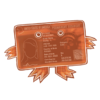Have you ever been stopped by a border agent or TSA officer for “secondary inspection?”
Because you've been stopped for secondary inspection
If so, DHS keeps a permanent record that you received heightened scrutiny. You might be on a watch list, or deemed “high risk” by a DHS algorithm used to predict potential law violators.
After 9/11, the U.S. government created multiple “watch lists” to screen travelers, especially those flying on planes and traveling internationally. Often, inclusion on watch lists is unknown to a person until they try to board a plane or cross a border.
The FBI’s Terrorist Screening Database (TSDB)Opens in new tab is housed at its Terrorist Screening Center. The TSDB includes the No Fly List, the Terrorist Watchlist, and the Selectee List. These lists subject travelers to extended searches and interrogation. The No Fly List is allegedly a small part of the database. But by 2013, hundreds of thousands of people were tracked by the TSDB because either a federal agent or an algorithm suspected that they may have some involvement with terrorism. That number hit 1.2 million by 2017, according to court records.
Some other data systems you may encounter include TECS/ICMOpens in new tab and ATSOpens in new tab.
To see what databases would track you if your answer had been no, click the no button.
If you've ever entered the US
If you travel internationally, you have files in DHS databases, even if you have not been stopped for questioning. If you’ve passed through a US border checkpoint in a car, bus, on a boat, or on foot, you have a permanent record on file that details your journey and identity.
If you have ever entered the U.S. on a immigration or non-immigrant visa, you may have records in these DHS databases, among others:
- IDENT/HARTOpens in new tab
- CIS (Central Index System)Opens in new tab
- CLAIMS 3 & 4Opens in new tab
- Person Centric Query Service (PCQS) Opens in new tab
TECS/ICMOpens in new tab archives notes on any previous US border crossings. ATSOpens in new tab checks whatever records you do have to determine if you will be stopped by TSA or CBP agents in future travels.
To see what databases would track you if your answer had been yes, click the yes button.
- Terrorist Screening Databases (TSDB) Opens in new tab Because you've been stopped for secondary inspection
- Computer Linked Application Information Management System (CLAIMS 3 & CLAIMS 4) Opens in new tab If you've ever entered the US




